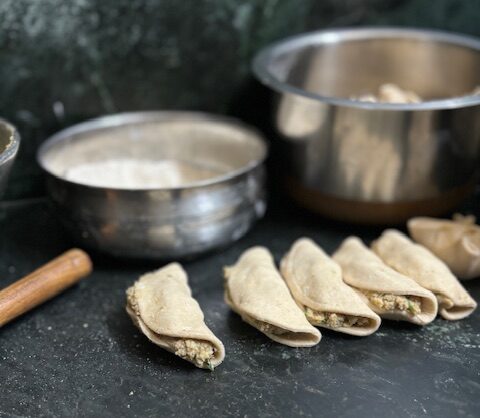
Growing up, Ankita had a deep aversion towards dal fara. She began to warm up to the dish when it was the only thing available to eat while being home alone. For Ankita, dal fara is a unique preparation; online searches predominantly reveal recipes by home chefs with very little mainstream coverage. While it is consumed throughout the year, it is a mainstay during Karva Chauth. Of late, dal fara has become Ankita’s go-to meal when she craves home-cooked food, or even when recovering from an illness.
| Split white urad dal | 1½ cup | 100 grams approx. |
|---|---|
| Bengal gram (chana dal) | ¾ cup | 100 grams approx. |
| Arhar (split toor) dal | 1½ cup | 100 grams approx. |
For the masala:
| Cumin seeds | 1½ teaspoon |
|---|---|
| Garam masala powder | ¼ teaspoon |
| Turmeric powder | â…“ teaspoon |
| Red chilli powder | 1 teaspoon |
| Asafoetida powder (hing) | a pinch |
| Green chillies | 2 |
| Garlic, peeled | 3 cloves |
| Salt | to taste |
For the dough:
| Whole wheat flour | 2 cups | 230 grams approx. |
|---|---|
| Rice flour | 1 cup | 120 grams |
| Vegetable oil | 1 tablespoon |
| Salt | 2-3 pinches |
| Water | 1 cup | 240ml approx. |
For the tempering (optional):
| Vegetable oil | 2-3 tablespoons |
|---|---|
| Cumin seeds | 1½ teaspoon |
| Curry leaves | 5-6 |
| Asafoetida powder (hing) | a pinch |
| Fresh coriander leaves, chopped | to garnish |
What You Will Need
Mixing bowls, stock pot or a deep vessel, rolling pin, mixer-grinder, kadhai (optional)
Instructions
In clean, separate bowls, soak the urad dal, Bengal gram (chana dal), and arhar dal in water overnight, or at least for eight hours.
After soaking, drain off the excess water and combine the dals together. Grind the dal mixture in batches until coarse. Keep aside.
Grind all the ingredients for the masala, including the chillies and garlic, together into a fine paste. Add a few tablespoons of water to aid this process, if needed. Keep the masala mixture aside as well.
In another clean bowl, combine the whole wheat flour, rice flour, 2-3 pinches of salt, a tablespoon of oil, and approximately one cup of water. Knead this mixture into a pliant dough, similar in consistency and texture to a chapati dough. Keep the dough aside, covered using a damp cloth to prevent it from drying out.
Combine the dal mixture with the masala paste, stirring well to ensure that the masala is evenly dispersed. Adjust the seasoning to your preference with salt, if necessary. Make sure the mixture isn’t runny, as it will become difficult to handle while steaming.
In a stockpot or a deep vessel, heat some water until it begins to boil. Add a pinch or two of salt.
While the water is boiling, divide the dough into small portions. Roll each portion into 6-inch circular poori-like shapes. Repeat until you have used up the dough (approximately 10-15 pieces).
In each poori, place a tablespoon of the dal mixture and fold it into half. Seal the edges using some water to form half-moon-shaped dumplings. You can experiment with different shapes once the dal mixture is stuffed into the dough.

Once the dumplings are ready, gently steep them into the boiling water, allowing to boil on a low-to-medium flame for approximately 30-40 minutes. This will help the stuffing and the dough wrappers to fully cook.

There are two ways of serving dal fara: you can serve the cooked dumplings with some of the starchy water used for boiling, topping them with ghee. For Ankita, this is very comforting, particularly when recovering from an illness.
The second way to serve it is to toss it in a tempering. Drain out all the water once the dumplings are cooked and allow them to cool. Once they reach room temperature (or if you have leftovers), slice them into thin strips. Heat 2-3 tablespoons of oil in a kadhai and add the cumin seeds, curry leaves, and asafoetida once the oil is hot. Add the strips of dal fara and cook for a couple of minutes until the tempering is evenly dispersed,similar to an upma. Garnish with chopped coriander.
Ankita Gupta Dujari (@tokjhaalmishti_) is a sous chef at Sienna Store & Cafe in Kolkata.
This recipe is a part of ‘A Longing for Home Food Booth’, an oral food memories project from The Locavore’s immersive installation at the Serendipity Arts Festival, 2023.
Listen to the complete memory of the recipe by visiting this link: Dal Fara
You must be logged in to rate this recipe.

Sign in with email

